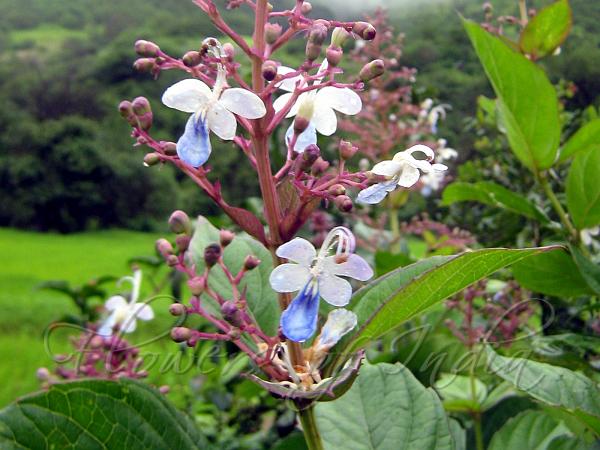|
| Blue Fountain Bush |
|

|

| File size | 316222 |
| Original date | 9/4/07 10:49 PM |
| Resolution | 1600 x 1200 |
| Flash | Flash did not fire, auto |
| Focal length | 5.4mm |
| Exposure time | 1/100s |
| Aperture | 2.8 |
| Focus Distance | |
| Metering Mode | Multi-segment |
| Camera make | Canon |
| Camera model | Canon PowerShot A430 |
| Sensor type | OneChipColorArea |
|
|
|
| Photo: |
Botanical name: Rotheca serrata Family: Verbenaceae (Verbena family)
Synonyms: Volkameria serrata, Clerodendrum serratum, Cyclonema serratum
Synonyms: Volkameria serrata, Clerodendrum serratum, Cyclonema serratum
Blue Fountain Bush is a shrub 1-4 m tall. Branchlets are densely yellow
velvet-hairy especially on nodes when young, becoming dark brown to
gray-yellow and hairless. Leaves opposite or in threes; leaf-stalk up to 5 cm
or leaf nearly stalkless; leaf blade oblong, obovate-oblong, elliptic, or
ovate, 6-30 2.5-11 cm, papery, velvet-hairy, margin subentire to minutely
toothed or sparsely coarse sawtoothed, tip tapering to pointed; veins 10
or 11 pairs, below prominent. Inflorescences are at branch-ends thyrses,
densely yellow-brown hairy. Bracts are stalkless, ovate to broadly ovate,
1.5-4.5 0.5-1.8 cm. Flowers white, bluish, or purplish, tube 7 mm. Petals
oblong to obovate, 6-12 mm. Stamens 2-4 cm long, protruding out. Style
long protruding. Drupes green when young, becoming black, spherical.
Medicinal uses: Root is useful in asthma,
cough and scrofulous affections. It is given in fever and is useful
in sinusitis. Juice of leaves is used with ghee as an application
to herpetic eruptions and pemphigus. Leaves are vermifuge and bitter
tonic. The root is one of the five ingredients of Brahata Panchamool and
has a large demand. The plant is considered as antitoxic, antiseptic,
astringent and styptic.
Root is useful in asthma,
cough and scrofulous affections. It is given in fever and is useful
in sinusitis. Juice of leaves is used with ghee as an application
to herpetic eruptions and pemphigus. Leaves are vermifuge and bitter
tonic. The root is one of the five ingredients of Brahata Panchamool and
has a large demand. The plant is considered as antitoxic, antiseptic,
astringent and styptic.
Medicinal uses:
 Root is useful in asthma,
cough and scrofulous affections. It is given in fever and is useful
in sinusitis. Juice of leaves is used with ghee as an application
to herpetic eruptions and pemphigus. Leaves are vermifuge and bitter
tonic. The root is one of the five ingredients of Brahata Panchamool and
has a large demand. The plant is considered as antitoxic, antiseptic,
astringent and styptic.
Root is useful in asthma,
cough and scrofulous affections. It is given in fever and is useful
in sinusitis. Juice of leaves is used with ghee as an application
to herpetic eruptions and pemphigus. Leaves are vermifuge and bitter
tonic. The root is one of the five ingredients of Brahata Panchamool and
has a large demand. The plant is considered as antitoxic, antiseptic,
astringent and styptic. | Identification credit: Rahul Prabhu Khanolkar | Photographed in Manipur. |
• Is this flower misidentified? If yes,